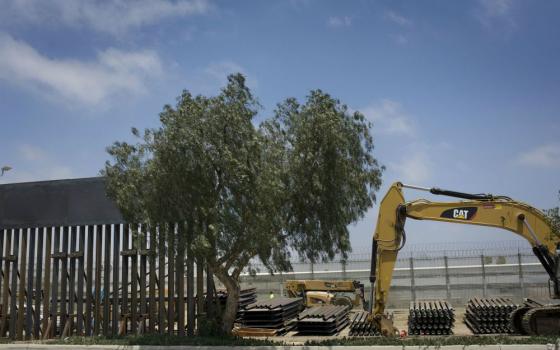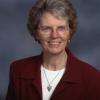Watching the news about immigrants and refugees on television and listening to it on the radio every day captures my imagination with images of suffering, but nothing compares to the virtual experience I had June 25.
When I was invited as a Conrad N. Hilton Foundation* board member to participate in "CARNE y ARENA (Virtually Present, Physically Invisible)" by Alejandro G. Iñárritu, an Oscar-winning Mexican director, at the Los Angeles County Museum of Art, I was intrigued but had no idea what I was getting into. The event was sponsored by Southern California Grantmakers for this one night only and was described as a solitary virtual experience of a desert border crossing between Mexico and the United States. (The exhibit is playing through the summer in Washington, D.C.)
Soon after I arrived, my name was called, and after a brief introduction, I entered the first room. It was dark except for two small screens explaining Iñárritu's purpose: to help people have a real understanding of what people suffer in trying to cross the border. From this room I passed through a door to another large cement-walled room lined with two rows of benches. Underneath the benches were worn-looking sneakers and water bottles. A message on the wall said they belonged to the people I would meet in this virtual production of migrants and refugees from Mexico and Central America seeking refuge in the United States.
The message on the wall also instructed me to remove my shoes and wait for an alarm and red blinking light that would signal entrance into the next part of my journey. The room was so cold and my bare feet felt stiff from walking on the concrete floor. The atmosphere of icy coldness and people's discarded belongings surrounding me triggered feelings of anxiety and images of people waiting in solitary fear, wondering what was going to happen to them.
After what felt like a long time, the alarm suddenly sounded, and the red light flashed. I opened the heavy door and entered another large, dark room, the floor covered with coarse sand and pebbles that hurt my bare feet. My eyes got used to the dark and an eerie red light before I saw two people come toward me with a backpack and goggles that they helped me put on. The guide told me everything would be very dark and I would not see the walls, but if I moved toward them, they would direct me back to keep me safe. He then put earphones on me, and I pulled the goggles down.
Suddenly, I found myself in a quiet, darkening desert with sand, sage brush and other bushes surrounding me. I turned around when I heard voices and in the distance saw a line of people coming toward me. Someone fell near me, and as one of the men rushed to help him, I heard others whispering.
Then, seemingly out of nowhere, I heard the loud whirring blades of a helicopter and saw search lights circling in the air. People began shouting, encouraging each other to hide. Border guards with guns shouted: "Get down, put your hands up, put your hands behind your head." I felt scared and fell to the ground too with my hands up.
We were kneeling on the gravel when suddenly, it was dark again. Almost instantly, we were ordered to get up and led to a table where a woman sat writing down names. As I walked toward her, I nearly stumbled on a mother comforting a small child.
As I went toward them, everything suddenly changed again as another helicopter arrived. There was more shouting by border guards, and when I turned, I saw one pointing a gun at me. I was paralyzed and confused. People around me were scrambling to hide. Guards were shouting: "There is one over there, get her."
I heard a guard talking to a young man, giving him orders, and a fellow migrant telling the guard, "He does not speak Spanish." The young man could only speak his indigenous language.
At times, I was a participant and at other moments an observer. I found myself moving from one to another in the confusion of the experience. My feelings cycled repeatedly from fear to confusion. I kept thinking, "How do people get through this?"
All ages of people were with me. I felt stunned and a deep need to cry as I went through this very short experience of chaos. I kept turning in circles to see where people were. All at once, it was over.
The guides took away the backpack, goggles and headphones and directed me to a door where I could find my shoes and bag. Although quite disoriented, I followed another dark hall, where videos introduced me to the people whose experience of this incident had been real, not virtual.
It was emotional to listen to their stories. They described how they came to be in the desert. Some were running from domestic violence; others, from fear of gangs who threatened to take their children. Some children, thinking they were going on vacation, were in reality sent alone by their parents. Some hoped to find work to support their families.
They told how, on the journey, their few belongings were taken; family members were pulled away and separated from them. They faced threats of sexual assault, dehydration, hunger, fear and exhaustion along with the shock of coyotes being collaborators with border guards who turned them in. The stories of betrayal on so many levels were heartbreaking.
They described the experiences of detention — being held in ice-cold rooms without covers, being shouted at and harassed, fed poorly. One boy told of his embarrassment when he was put in a women's cell with only one pot in the middle of the room for all to use as a toilet.
They also told of how they survived: Some have been able to go to school, get jobs, pay off the coyotes and be reunited with family or extended family.
But as I listened, I wondered how, even though they survived it all, they will get over the trauma and the humiliation of being considered and treated like criminals. They spoke sadly of this lingering pain.
*The Conrad N. Hilton Foundation funds Global Sisters Report.
[Joyce Meyer is a member of the Sisters of the Presentation of the Blessed Virgin Mary and GSR's liaison to women religious outside of the United States.]

